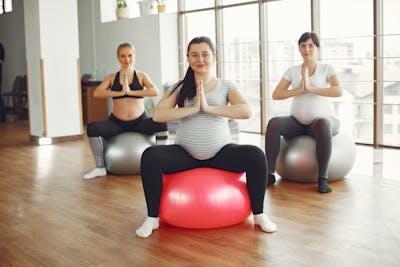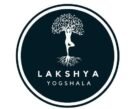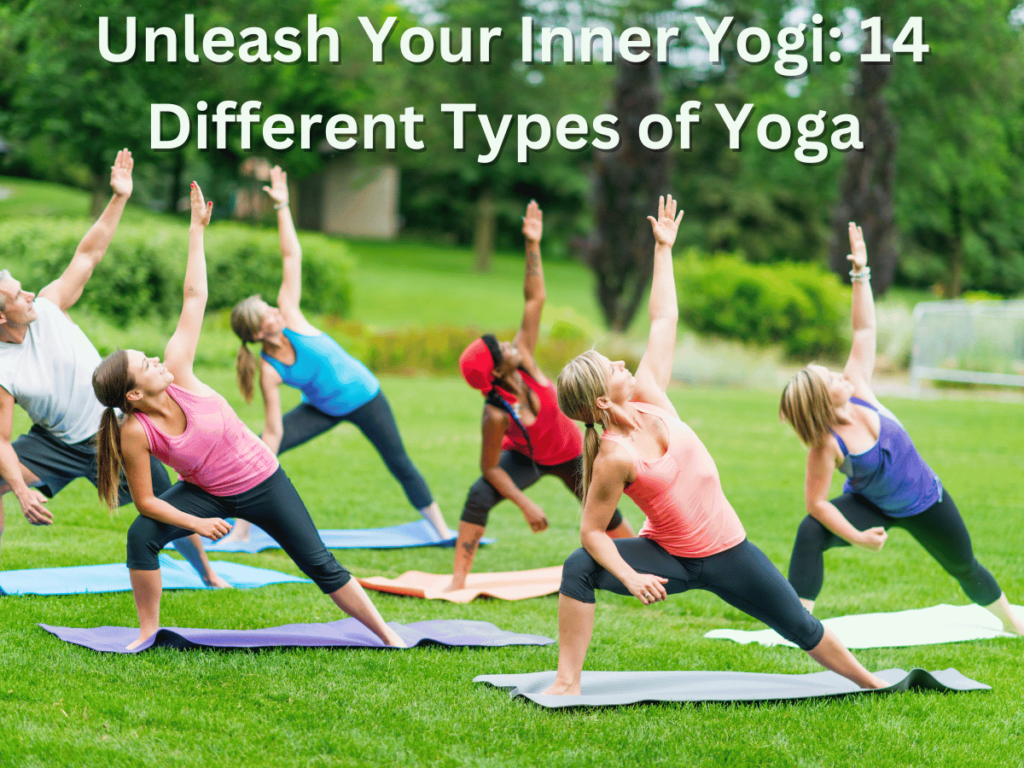Unleash Your Inner Yogi: 14 Different types of Yoga
Follow through as we explore the different types of yoga and their benefits.
The Origin of Yoga
The history of this practice can be traced to the pre-colonial practice in medieval India.
Vedic Scriptures to Instagram: 5000-Year Journey of Yoga
The earliest mention of Yoga was in ancient sacred texts called the Rig Veda. It was
further refined and developed by Rishis who documented their practices in the
Upanishads, a huge work containing more than 200 scriptures.
This practice is among the six schools of Philosophy in Hinduism and is a major part of
Buddhism. Currently, it is being brought to the diverse and global audiences and it is
loved by many.
The 8 Limbs of Yoga: Poses and More
It is believed that a person must practice and master one pose before moving to the
next. These poses go a long way to inculcate the values of good behavior, justice, self-
discipline and concentration. Here’s a list of them: You Can also read 12 Types of
Meditation.
- Yamas
- Niyamas
- Asana
- Pranayama
- Pratyahara
- Dharana
- Dhyana
- Samadhi
Here Are Different Types of Yoga And Its Benefits
1. Hatha Yoga: The Foundation of Western Practice
This uses physical techniques to channel energy. These techniques date back to the first century C.E. In Western culture, it is understood that this yoga style integrates the idea of ethics, diet, cleansing and meditation for spiritual development of the practitioner.
Mastering the Basics: Key Hatha Poses for Beginners
- Tadasana pose: Helps to improve knees, joints and blood circulation.
- Adho Mukha Svanasana: Help to cure anxiety and fatigue.
- Vrikshasana pose: For rejuvenation and balance.
- Paschimottanasana: Reduces tension and belly fat.
The Science Behind Hatha Yoga
Hatha yoga is all about understanding how your body works, and using poses to drive energy to certain directions. Preparing your body before you go intense forms of meditation is vital. Otherwise, there will be a blockage of energy and nothing will pass through. With hatha yoga, your body can adjust itself gently and joyfully.
2. Vinyasa Flow: Dancing with Your Breath
This pose blends movement and breath to foster a beautiful dance between body and mind.
Synchronizing Movement and Breath: The Vinyasa Advantage
Each transition between poses is often linked by a breath. This creates a smooth experience. This experience ignites a moving meditation where practitioners are still and calm. The breath, then, helps to transform each pose into a graceful sequence, enhancing physical and mental benefits.
Creative Sequences: Why No Two Vinyasa Classes Are Alike
Vinyasa flow classes are fluid, that is, they are connected in a sequence. However, they are often built upon a theme and different yoga teachers adjusts their sequencing in different ways according to these themes. As a result of this, there is creative freedom and practitioners are kept fresh, engaged, and inspired.
3. Ashtanga Yoga: A Powerful Practice
This type of yoga combines poses and breath control for self-improvement. It is traced to the yoga sutras of Patanjali.
The Six Series of Ashtanga: A Lifelong Practice
There are six Ashtanga series: Primary, Intermediate, Advanced A, Advanced B, Advanced C and Advanced D. Practitioners are expected to go through them in their correct order and gain mastery over one before moving to the other.
Famous Ashtangis: How This Style Shaped Modern Yoga
This supreme and perhaps the hardest yoga style was made famous by Patthabi Jois. In the modern world (particularly in the ‘60s), he brought this style to light and quickly found prominent followers.
4. Iyengar Yoga: Precision and Alignment
This style emphasizes precision, alignment and attention to detail in yoga poses. It uses props to support and enhance the practice.
Props as Teachers: Unlocking Your Body’s Potential
This yoga style uses a variety of tools and props to support alignment. Blocks, straps, blankets and bolsters are used to modify poses where necessary. These helps those who are new to yoga to benefit from the practice. They also help them work at their own pace, regardless of their strength and flexibility.
Therapeutic Applications of Iyengar
According to research, this yoga can decrease stress, anxiety and depression. Furthermore, the yoga style is effective in treating blood pressure disorders.
5. Bikram and Hot Yoga: Sweat it Out
This yoga helps to improve strength and flexibility. The heat and sweat is an intense workout for your heart and muscles.
The 26+2 Sequence: Breaking Down Bikram
There are 26 yoga poses and 2 breathing exercises. Each is practiced in a heated room. These helps to stretch and heal the entire body. The postures include:
- Standing deep breathing
- Half moon pose
- Hands to feet pose
- Awkward pose
- Eagle pose
- Standing head to knee pose
- Standing bow pulling pose
- Balancing stick pose
- Standing separate leg stretching pose
- Triangle pose
- Leg head to knee standing
- Tree pose
- Toe stand pose
- Dead body pose
- Cobra pose
- Wind removing pose
- Locust and full locust pose
- Blowing in firm pose
- Fixed firm pose
- Bow pose
- Camel pose
- Half tortoise pose
- Rabbit pose
- Stretching pose
- Head to knee pose
- Half spine twist pose
Hot Yoga Myths Debunked: Separating Fact from Fiction
Myth 1: Only the fit can do it
Individuals of all fitness levels can do it.
Myth 2: You can only lose weight through it
Bikram and hot yoga benefits are beyond that. It can reduce stress and improve heart health.
Myth 3: It is dangerous.
It is safe if precautions are adhered to.
6. Kundalini Yoga: Energy Awakening
This yoga involves movement and breath work. The aim of Kundalini yoga is to prepare and your energy centers for activation.
Kriyas and Mantras: Unique Elements
Kriya is a series of exercise sets that combines visualization, locks and chanting to produce specific effects. On the other hand, mantras are sacred words or phrases that brings consciousness into being. Both of these elements are employed into the practice to bring unique benefits.
The Kundalini Controversy: Understanding Its Reputation
The controversy surrounding this practice of yoga has brought concerns to the heart of many. Some have said that the practice is being linked to brainwashing, tactics and abuse. Some even claim that it is manipulative. However, this practice has gained a lot of defenders.
7. Yin Yoga: Smooth Stretch
Yin yoga is a slow-paced style for relaxation purposes. It was founded by the yoga teacher Paulie Zink. Added supports like cushion or blanket are used for maximum comfort to help you “melt” into the asana (postures).
Fascia Focus: Why Yin Is Essential for Modern Bodies
Studies have shown that this yoga style is good for one’s health. This is because it targets the fascia (a thick connective tissue). This tissue connects the body’s muscles and when it stiffens, it limits blood circulation and flow. Regular yoga practice can release such stiffness.
Yin and Yang: For Yoga Balance
These elements cannot exist without each other. The Yin are internal and cooling qualities. The Yang are external and warming qualities. Combining them gives you balance and a sense of harmony.
8. Restorative Yoga: Promote Rest
Restorative yoga is a gentle style for relaxation. It helps hold poses for extended periods with additional supports.
Benefits of Restorative Yoga: The Physiological View
Research says that this type can balance one’s nervous system. In addition, it eliminates pain and improves sleep quality. More to that, it improves muscle recovery and breathing. It also improves flexibility and relaxation.
How to Practice: Essential Props and Poses
It is required to use yoga bolsters, yoga blocks, straps, eye pillows and sandbags. These can give your body what it needs to fully let go of tension and relax. Poses like child pose, twists and gentle backends can also provide support and comfort at home.
9. Power Yoga: Mindfulness and Fitness
This is a fitness-based approach to the traditional style of yoga. It focuses on strength and endurance. Unlike other types, this one focuses primarily on vigorous physical workouts.
From Gym to Studio: The Evolution of Power Yoga
Power yoga stems from Ashtanga yoga. It was adapted from Ashtanga yoga students in the late 20th century (in the 1980s). These students separately added their own spins on the style and branded it.
Building Strength and Flexibility: Power Yoga’s Dual Focus
This dynamic style uses strength training to build muscle endurance. Doings this helps to engage the core and improve flexibility while enhancing cardiovascular health. In this practice, we can bring all our experiences to the present moment. The more present you are, the greater the capacity for excellence. And the more capable you will be to pursue a balanced fitness routine.
10. Jivamukti Yoga: Spirituality in Motion
This yoga focuses on aligning your breath and spiritual intention with movement (motion). This yoga is a gentle type that combines movements, breathing techniques and chanting that are done for a couple of minutes.
The Five Tenets of Jivamukti: Asana and More
Shastra, Bhakti, Ahimsa, Nada and Dhyana are the five tenets. Each of these invokes a feeling of compassion, the practice of meditation, the importance of learning, devotion to God and sound chanting for optimal experience. You can also read a how to do simple meditation at home.
Famous Jivamukti Sequences: Challenging Body and Mind
The Beginner Vinyasa is a sequence of postures done in a slow pace. It is a yoga for beginners. The Magic Ten consists of ten poses held for ten breaths and can be done in ten minutes. The Spiritual warrior is ideal for those who have only an hour to spare. It is quite vigorous and is best suitable for advanced practitioners.
11. Sivananda Yoga: Holistic Wellness
This is a holistic yoga that provides healing experiences for the body and mind. It also gives people the ability to retain body vitality.
The Five Points of Yoga: Sivananda’s Comprehensive Approach
- Proper exercise – Asanas
- Proper breathing – Pranayama
- Proper relaxation – Savasana
- Proper diet – Vegetarian
- Positive Thinking and Meditation – Vedanta and Dhyana
These points have specific requirements which must be fulfilled in order for the body and soul to function optimally.
A Day in a Sivananda Ashram: What to Expect
It usually starts and ends with satsang (a core practice of our Ashram life). Here, we meditate silently, chant and listen to a yoga discourse. Yoga classes are held twice a day. Afterwards, south Indian vegetarian meals are served. Every morning, Karma Yoga is done to help you become part of Ashram life.
Daily lectures about the deeper practices of yoga are also given to enhance the practice even further.
12. Anusara Yoga: Heart-Centered Practice
This style of yoga centers on the heart. Its aim is to align your pose with your body, heart and mind and give you a deeper connection with higher consciousness.
The Universal Principles of Alignment: Anusara’s Core Teaching
- Open to Grace/Set the Foundation
- Muscular Energy
- Expanding Spiral/Inner Spiral
- Contracting Spiral/Outer Spiral
- Organic Extension
These principles connect the poses to the practice of yoga. It shifts focus from perfecting a pose to enhancing the goodness that already exists within.
Anusara’s Rise and Fall: Lessons for the Yoga Community
The founder of Anusara yoga was engulfed in a scandal that led to his fall. This shocking revelation put the future of the yoga style in doubt. The print media were able to catch up, some making claims that scandal is nothing new. The instability of this has led to the conclusion that in the end, the truth will be revealed.
13. Prenatal Yoga: Nurturing Two Lives

This kind offers support to expectant mothers through their pregnancy period. It provides opportunity for them to bond with their growing baby.
Trimester-Specific Practices: Adapting Yoga for Pregnancy
In their first trimesters, expectant mothers are taught not to do too much. They want to avoid heated environment and they want to push past their 8.5 out of 10 on the Perceived Effort Scale.
In second trimesters, they are taught to prioritize movements that reduces back and pelvic pain. Modifying poses laying on your back or belly is also important.
During the third trimesters, expectant mothers adapt to the poses from the first trimesters. Some can reduce their range of motion to avoid ligament pain.
Benefits: From Emotional View
Prenatal yoga can help women express their feelings without judgment. Through breathing exercises, they cultivate resilience and inner calm, giving them the ability to navigate the challenges of pregnancy with ease.
Furthermore, it encourages mothers to connect with their growing baby. This goes a long way to foster parent-child relationship even after birth. It also prepares women with the endurance and strength needed for childbirth.
14. Aerial Yoga: Defying Gravity
This is a new type that uses a silk fabric hammock as a tool to help practitioners achieve traditional yoga poses with ease.
The Silk Hammock: Your New Favorite Prop
It is made of a 100% nylon aerial fabric with a low to medium stretch that is soft on your skin. It can support weight up to about 400 pounds. It has two daisy chains and two carabiners and can be easily installed. This helps those who suffer from back pain or stiffness to get a stretch.
Aerial Yoga Benefits: Spinal Decompression and More
First, it reverses gravity and relieves the pressure in our bodies. It decompresses the spine, causing fresh oxygen and other nutrients to nourish the body. It is also a low impact workout that can increase heart rate. Aerial yoga can also deepen your core strength and improve blood circulation.
Choosing Your Yoga Path: Factors to Consider
With the different yoga types available, here are a few things to consider:
Personality Types and Yoga Styles: Finding Your Match
To find your match, you need to know what you want out of a yoga class. The style you choose should reflect on your goals. Consider, too, the kind of person you are. If you’re busy or self-disciplined or determined or slow-paced person, you should find something that matches that personality. Your comfortability is also key.
When to Mix Styles: The Benefits of a Varied Practice
This depends too on what you hope to achieve. Beginners can benefit from trying different styles with the goal of finding one that fits. This can help them gain fresh insight. Advanced practitioners need not do that.
The Future of Yoga: Emerging Trends and Innovations
Find below various trends that are reshaping the yoga practice:
Tech and Yoga: AI and Virtual Reality
With tech, practitioners can be immersed in a serene environment without leaving their home. The help of AI-driven apps can also provide customized experiences for various individuals and help them learn more about yoga experience.
Fusion Styles: When Yoga Meets Other Disciplines
Martial arts, Pilates and dance can help individuals meet a range of their fitness goals without taking many different classes.

